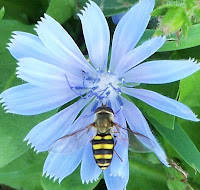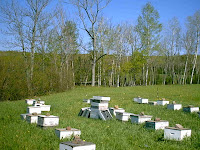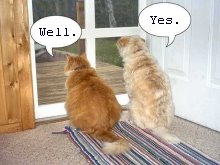 White Birch Apiary: This article originally appeared in the July 2008 issue of Marquette Monthly. The first two photos are by Darlene Wrona.
White Birch Apiary: This article originally appeared in the July 2008 issue of Marquette Monthly. The first two photos are by Darlene Wrona.***
Honey is nothing less than concentrated nectar; … the essence of its surroundings … flowing gold into the pot through the transforming power of the bee. - From “Sweetness & Light: The Mysterious History of the Honeybee,” by Hattie Ellis
***
I went and visited a guy north of town, north of Bruce Crossing, that is, who makes and sells honey. He’s not to be confused with the guy south of town who used to make and sell honey. That was Cole’s Apiary, run by Otto Cole and then his son Walt. They’ve been out of business twenty some years now. In fact, it’s the guy north of town, Les McBean, who bought all their stuff, “everything related to bees,” as he puts it. McBean calls his business White Birch Apiary, and you’ve probably seen his honey bears and honey jars and jugs of honey in local grocery stores and gift shops.
“I have a huge white birch tree on the north side of my house,” McBean says, explaining the origin of the name. “People think it’s white birch honey. Birch trees don’t make honey. Basswood does, but birch trees don’t.”
That’s right, White Birch Apiary, with the gold label, sometimes a little crooked because McBean puts those labels on himself. Yep, thousands of labels, all by hand. Screws on the tops, too. So now he’s got carpal tunnel syndrome. A beekeeper for 21 years and a teacher of beekeeping workshops for the Michigan State University Extension Service, McBean works by himself for himself with the help of Bug’s, an orange cat. And, well, he is a beekeeper, so “I get stung 15 to 20 times a day,” he says. But don’t go thinking he’d change a thing. Being a beekeeper may not be what he set out to be, but now it is definitely what he is.
Back in the 1960s McBean, originally from Peck, Michigan, spent three and a half years at Northern Michigan University studying business before heading off to California, trying out a couple more schools, being refused by the Marines, ending up in a flight path that took him around the world and then some. He was on the “hippie trail,” hitchhiking, riding the Orient Express, seeing Malaysia, Nepal, India, Turkey, Iran, Thailand, Hong Kong; meeting people and seeing things that would shape and change his life; says he got the best education he could have gotten anywhere, traveling those years and then doing what he thought he’d never do: coming home.
In the mid-1970s McBean bought a wobbly log cabin in the middle of the Ottawa National Forest, north of Bruce Crossing, and life began to gel like a little drop of nectar in a honeycomb cell. He was dreaming, he says, “a corny dream” to live off the land. For the next few years, though, McBean worked, not quite happily, for the forest service. Then Cole’s Apiary came up for sale. “I needed a job and it was there and I talked with the guy and I thought I’d give it a shot,” McBean says.
But like a beeline with curves, he first taught English in Japan for a year, making enough money to buy the apiary. But when he returned to Bruce Crossing, Walt Cole wasn’t ready to let go, so McBean started from scratch, buying 25 colonies of bees—more than a quarter million bees destined to grow to more than a million by mid-summer. Then, around mid-summer, Walt did let go and sold to McBean, lock, stock and hive—150 hives, to be exact. Suddenly McBean was in business with millions of bees doing what bees do: making honey.
“My first year I had 18 to 20 barrels of honey and no customers,” McBean says, “so I had to sell it to the wholesale brokers, the commodities market in Chicago. I didn’t get any money for it. I got like 52 cents a pound … I thought, ‘This isn’t working.’ … That’s when I decided I’m going to have to build up my own market and label under my brand name. … Of course, I do twice as much work.” In order to keep the business going, for a number of years he taught English in Japan during the off-season.
Today McBean has 300 bee hives in seven bee yards in pastures north and south of town (yes, Bruce Crossing). Along with caring for all those bees, in a year he will bottle and sell about 13,000 pounds of honey. This makes him, he guesses, the largest beekeeper in the Upper Peninsula.
 Beekeeping is shrouded in otherworldliness. The white wooden hives, designed by a preacher in the mid-1800s, squat like rejected hat boxes in vibrant green pasture marked off by a low electric fence that wards off bears. The beekeeper, in white coveralls, heavy gloves, pith helmet and veil looks vaguely like a mad scientist from a 1950s’ B-movie. Then there’s the smoker—a tin can with a fire inside, a spout, and small attached bellows for puffing white smoke on the bees so they will think “Fire!” and crawl back into the hive, away from the beekeeper.
Beekeeping is shrouded in otherworldliness. The white wooden hives, designed by a preacher in the mid-1800s, squat like rejected hat boxes in vibrant green pasture marked off by a low electric fence that wards off bears. The beekeeper, in white coveralls, heavy gloves, pith helmet and veil looks vaguely like a mad scientist from a 1950s’ B-movie. Then there’s the smoker—a tin can with a fire inside, a spout, and small attached bellows for puffing white smoke on the bees so they will think “Fire!” and crawl back into the hive, away from the beekeeper.Yet beekeepers get stung.
“I was working with Walt, this was just before I bought the business,” McBean begins, “and we had moved some colonies to a new location and gone back the next day to pick up the last hive. I was dressed for the job, fully protected with bee suit, veil, and gloves. Walt, being the old-timer he was, took off his veil when we put the hive on the back of his truck. We were only moving the hive about a mile, so I left my veil on. I got out of the truck and picked up the hive and saw Walt waving at some bees. I went ahead and moved the hive to the stand and looked around for Walt and at first couldn’t see him. Then I spotted him lying in the field, trying to pull his suit over his head. He was being attacked by the bees. I got the smoker and ran over to him and smoked him down to get the bees away. He said he figured he got stung about 100 times. We got in the truck and he said, ‘Let’s go have coffee.’”
Walt warned McBean that someday it would happen to him, and sure enough it did.
“About ten years later I went on my ATV to a yard just about a mile from my home. I had some bear problems and wanted to just take a look at the yard. I was wearing shorts, flip-flops, and a t-shirt. When I got to the yard everything was OK, but I noticed one hive which needed a honey box. I could tell because the bees were clustering outside. I had some boxes stacked up waiting to be put on so I walked over to the hive and took off the cover and sat it on the ground, picked up the honey box to put it on the hive and started to get a few stings. I lifted the cover from the ground, and as I did, a few hundred bees which were clinging to the inside of the cover came after me. I ran to my ATV and jumped on and headed home trying to brush the bees off me. I got stung all over.”
McBean enjoys the inside work of an apiarist as much as the outside. In the fall you’ll find him in a room partially heated by a wood stove inside a large pole building, listening to music and extracting honey. A bee makes honey by sucking nectar from a flower, spitting it into a honeycomb cell, fanning it with her wings to dehydrate it, and sealing the cell with a bit of wax, which she also makes. This is a bee’s way of making and storing food, and it is the surplus store that a beekeeper harvests. In the fall, McBean gathers full, capped honeycomb frames from the hives and places them one by one into the “uncapper”—a machine which removes the wax caps with a bit of chain flagellation. The uncapped comb is moved to a holding bin, then to the radial extractor, which is somewhat like that carnival ride that spins, the floor drops down but you stay plastered against the wall, howling. In the extractor the honey gets whipped out of the combs and falls to the bottom of the machine. When it’s full, McBean opens a spigot and the honey flows. It is stored in barrels, and prior to bottling McBean will filter and heat it to about 140 degrees. Honey labeled “raw and unprocessed,” however, will not be heated above 110 degrees, allowing it to retain its natural bits of pollen and live enzymes, which some claim is more healthful, counteracting seasonal allergies among other things.
 Over the years beekeeping basics have changed little, but the bees themselves are a different matter. Honeybees, not native to North America, were brought over by the Dutch in the 1640s. They spread quickly across the country. “When a bee colony gets too crowded, they’ll swarm out, and it’ll go off into the wild,” McBean explains. But now there are few wild honeybees left. Since the late 1990s honeybees have succumbed to all sorts of maladies such as Colony Collapse Disorder, disappearing bee syndrome, and the varroa mite. Large numbers have simply left the hive, disappeared, died, and no one really knows why. But they are social creatures, and in the hive they’re all over each other. Then, one bee goes out and finds some choice nectar, she comes back and tells the others, the rest go out and soon they are all over the same flowers. That’s pollination 101. And that’s the importance of bees. In California, add a few more hives to the almond field and the crop is doubled or tripled and so are the dollars lining someone’s pockets. Consider the fact that some bees are employed as migrant workers—their keepers packing up hives and moving them around the country to whatever field is blooming, being paid pollination fees, the humans, that is, not the bees—and you can see how any parasite or malady might rapidly spread. McBean likened it to Typhoid Mary going to the mall. Probably on a Saturday afternoon.
Over the years beekeeping basics have changed little, but the bees themselves are a different matter. Honeybees, not native to North America, were brought over by the Dutch in the 1640s. They spread quickly across the country. “When a bee colony gets too crowded, they’ll swarm out, and it’ll go off into the wild,” McBean explains. But now there are few wild honeybees left. Since the late 1990s honeybees have succumbed to all sorts of maladies such as Colony Collapse Disorder, disappearing bee syndrome, and the varroa mite. Large numbers have simply left the hive, disappeared, died, and no one really knows why. But they are social creatures, and in the hive they’re all over each other. Then, one bee goes out and finds some choice nectar, she comes back and tells the others, the rest go out and soon they are all over the same flowers. That’s pollination 101. And that’s the importance of bees. In California, add a few more hives to the almond field and the crop is doubled or tripled and so are the dollars lining someone’s pockets. Consider the fact that some bees are employed as migrant workers—their keepers packing up hives and moving them around the country to whatever field is blooming, being paid pollination fees, the humans, that is, not the bees—and you can see how any parasite or malady might rapidly spread. McBean likened it to Typhoid Mary going to the mall. Probably on a Saturday afternoon.But McBean’s main concern is the U.P. winter and the fact that his bees no longer seem able to survive it. For the past three springs he’s had to bring in bees from California. Then, if May is too cold with too many days not reaching the 60-degree mark, his bees won’t leave the hive, which means they’re not eating. Basically, they order in, and McBean delivers.
“It’s like your chickens or your cows,” he says. “It’s your herd, and you have to make sure that they’re healthy, that they’re happy, have a spacious home, food.”
Once it is warm enough, the worker bees, all female, are out foraging for nectar. In the spring it’s a sweet snack of popples, pussy willows, maple buds and dandelions. They gather the nectar, turn it into honey, feed themselves as well as the newborns that are climbing out of their honeycomb bassinets at a rapid rate as the queen of the hive lays more than a thousand eggs a day. By July the bees are making the honey that McBean will harvest. They’re wiping their feet on and sipping nectar from trefoil, wild sweet clover, basswood, and spotted knapweed, the flowers that bloom all around town, north and south of Bruce Crossing.

Bee
Beeswax
White Birch Apiary honey is available through our Stuff for Sale page.



